Sexing a Cockatiel

There is a lot of misinformation floating around the internet, and sadly, bird fairs, about the sexing of cockatiels.
I remember once looking for a female lutino pearl. I asked the lady at the table if she thought the bird was a female. She took
it out of the cage, swung a string with a washer tied to the end over it, and a few minutes later, she said it was a male.
This "method" of sexing cockatiels is called the pendulum method. It is not accurate, it is an old wive's tale, and pretty much
the same as guessing. Needless to say, I did not purchase a bird from her.
There are three ways of accurately sexing a cockatiel: 1) visually and 2) through genetics (please see the
section on genetics), 3) DNA sexing. To visually sex a cockatiel, it must have gone through
its first molt. ALL juvenile cockatiels look the same before their first molt. They all look like females. Sexing through genetics
requires a knowledge of the genetics of the parents, and an understanding of how genetics work. I will not go into genetics
on this page, please refer to the genetics page.
Visual Sexing Myths
You can sex a bird by the bars on its tail or dots on its wings. Nope, sorry, no cigar. While females
generally have bars and dots, they don't always. One of my males, a whiteface, has very well defined bars on his tail.
He is definitely not a female. :) So this method isn't great for determining gender.
Louder, more aggressive birds are males. Usually. Not always. There are some very sweet, quiet
males, and there are some loud, non-snuggly females. However, if genetics doesn't help the breeder determine the sex,
they usually will use this method as a sort of backup to help figure out who's what. If you're looking for a specific sex,
then this way of sexing might disappoint you.
Male lutinos have brighter cheekpatches. No. There is no way to visually sex a lutino or a pied. Period.
Below is a listing of many mutations of cockatiels. I will include photos as they are available. Males are on the left, females on the right.
This is only for single mutations, birds like cinnamon pieds, or pearl lutinos, are not included here, as there are quite a few
combinations possible. However, any bird that is a full pied (not split to it) cannot be visually sexed. Any bird that displays
lutino, cannot be visually sexed. For example, a whiteface lutino. You can sex the whiteface, but lutinos cannot be visually
sexed. Therefore, the whiteface lutino cannot be visually sexed.
Takoda Aviary's Visual Cockatiel Identification
| Normal greys |
| The most common mutation of cockatiel.The bird is grey, with white wing tips and orange cheek patches. The male develops a bright yellow face with bright orange cheek patches, the female retains the grey face (usually with small amounts of yellow) and dull cheekpatches. |
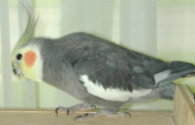 |
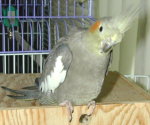 |
| Male | Female |
| Cinnamons |
| Very similar to normal greys.The bird's body, instead of being grey, is a shade of brown, with white wing tips and orange cheek patches. The male develops a bright yellow face with bright orange cheek patches, the female retains the grey face (usually with small amounts of yellow) and dull cheekpatches. |
| No Photo Available. |
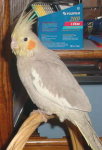 |
| Male | Female
Owned by Debby |
| Whiteface |
| Similar to normal grey. The bird is grey, with white wing tips and silvery cheek patches.
The male develops a snow white face, the female retains the grey face with silver cheekpatches. |
 |
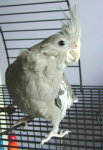 |
| Male | Female |
| Yellowcheek |
| Similar to normal grey. The bird is grey, with white wing tips and yellow to yellow-orange cheek patches.
The male develops a bright yellow face, the female retains the grey face (usually with small amounts of yellow) with the yellow cheekpatches. Sometimes the cheeks may blend in completely with the yellow head of the male. |
| No Photo Available |
No Photo Available. |
| Male | Female |
| Pearl |
| This mutation is highly sexually dimorphic, with the female being the more attractive of the sexes.
The mature female has a bright yellow head with bright orange cheek patches, with pearling all over the body and wings. A good specimen has pearlings on the chest as well. Males look like normal greys, the grey body, white wing tips, and yellow head with bright orange cheepatches. A good specimen will retain a few pearls, loosely scattered over the body. |
| No Photo Available |
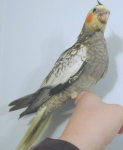 |
| Male | Female |
|
| Lutino |
| This mutation cannot be visually sexed. There are two variations on this mutation.
The bird may either be completely yellow, with orange cheekpatches, or a yellow head with orange cheekpatches, and a white body. |
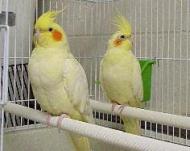 |
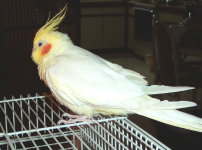 |
| | "Rickki" owned by Ron Howard |
| Pied |
| This mutation cannot be visually sexed. The bird will have grey and yellow/white patches all over its body, with bright orange cheekpatches. This
is a highly variable mutation - some are more pied than others. |
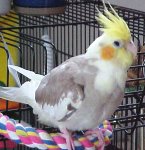 |
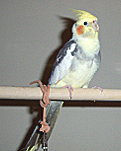 |
| "Buddy" owned by Carole Obermeyer | "Sunny" owned by Ron Howard |
|